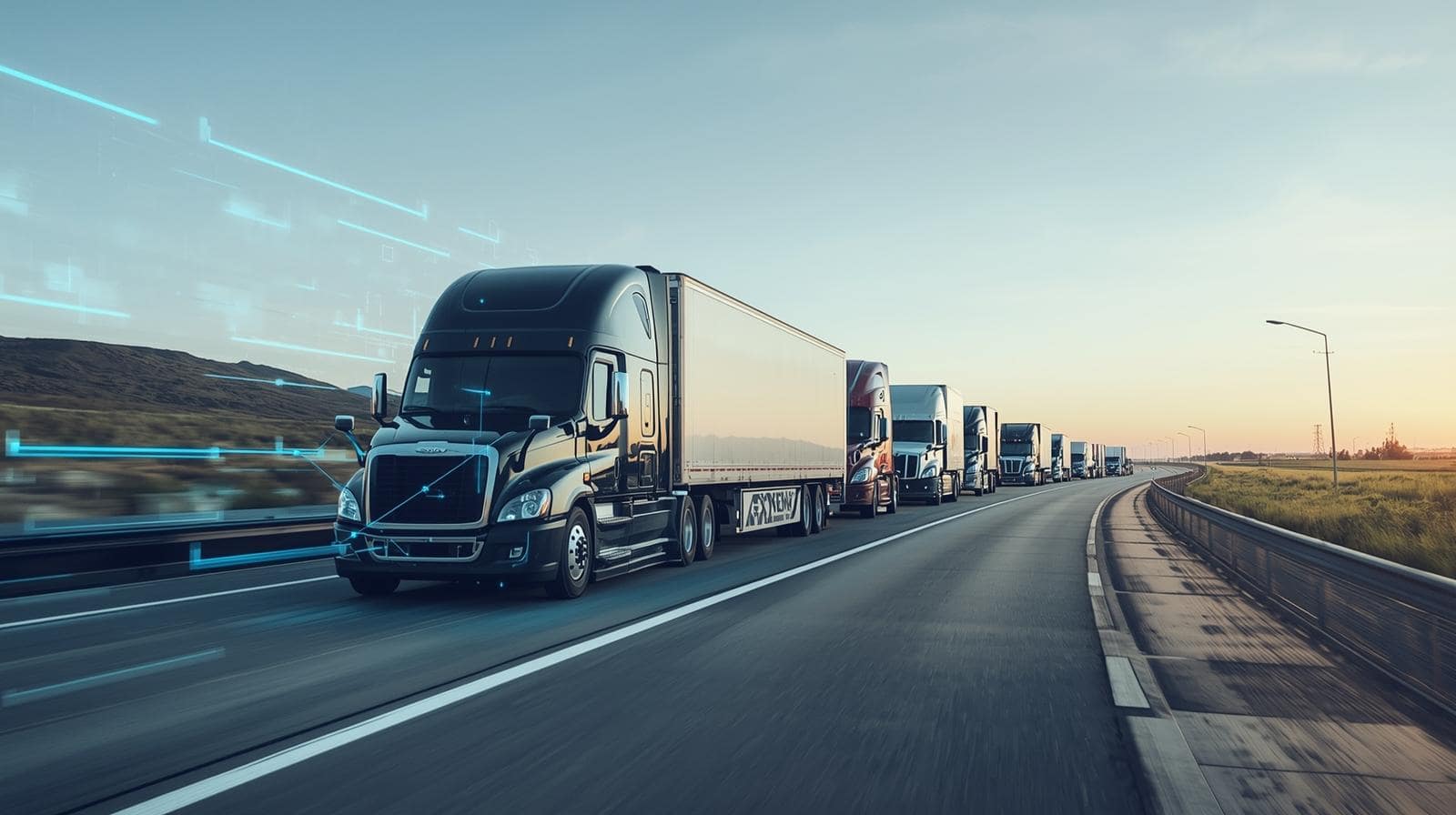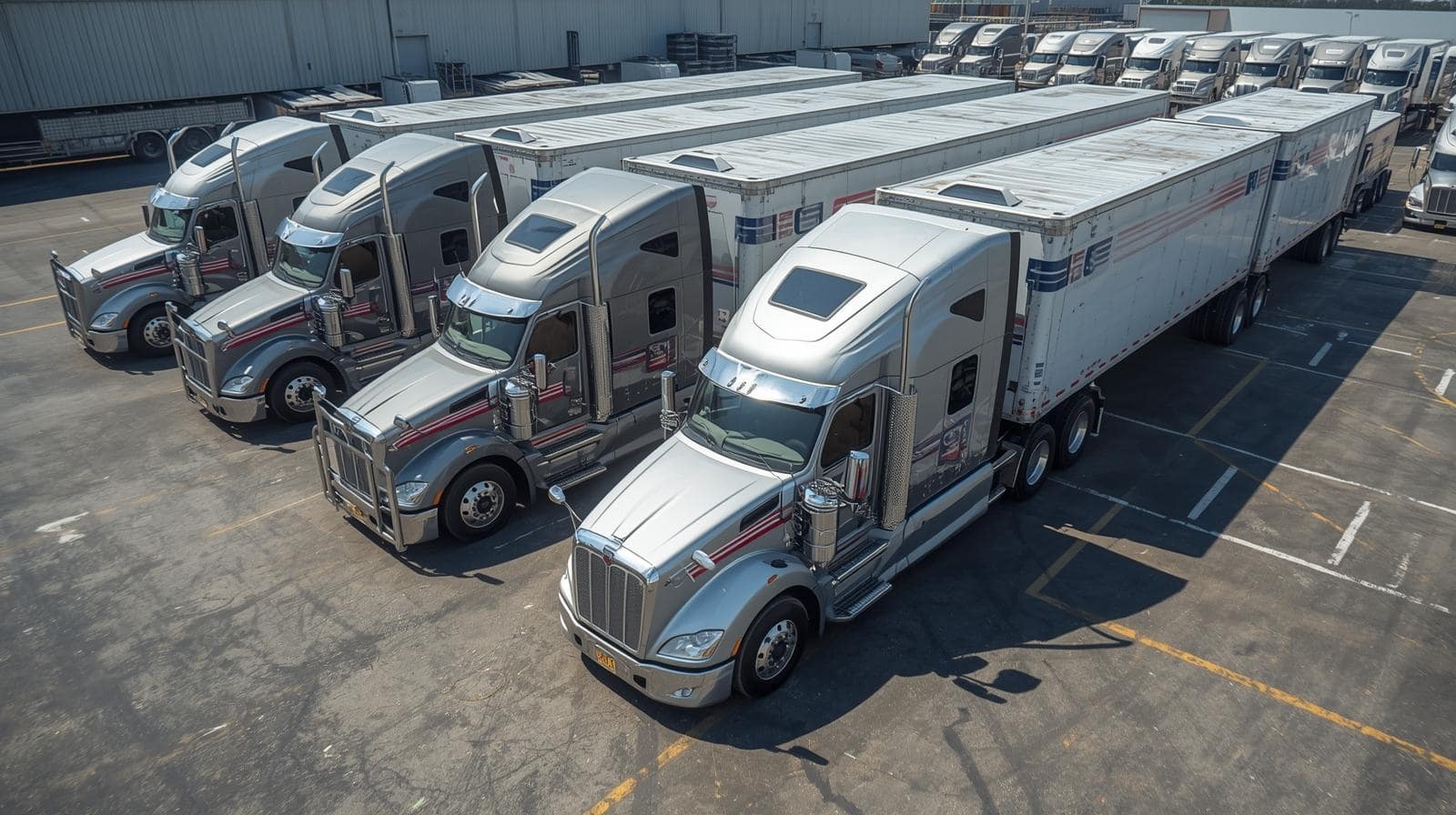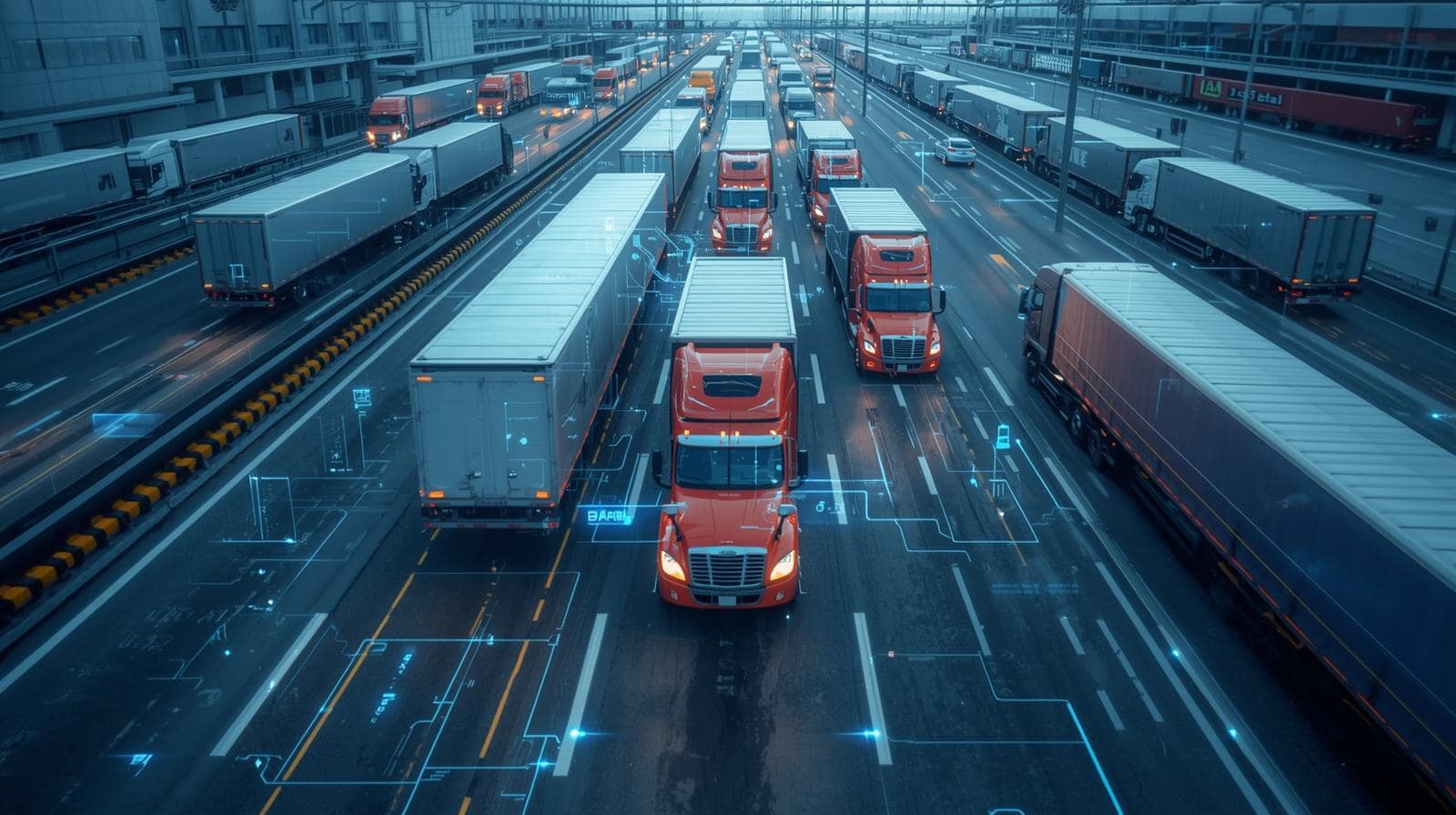Contents
- 1. The Power of Real-Time Data in Freight Management
- 2. Optimizing Routes and Reducing Delays
- 3. Real-Time Communication: Keeping Everyone on the Same Page
- 4. Improving Customer Experience with Real-Time Data
- 5. Streamlining Operations Through Automation
- 6. The Future of Real-Time Data in Freight Management
- 1. Automation: The Future of Freight Handling
- 2. Artificial Intelligence and Machine Learning
- 3. Last-Mile Delivery Innovations
- 4. Blockchain: Transparency and Security
- 5. Sustainability: Green Logistics is the New Norm
- 6. Supply Chain Resilience and Diversification
- 7. The Internet of Things (IoT) and Data Analytics
In the fast-paced world of logistics, the ability to act quickly, make informed decisions, and optimize operations has never been more crucial. Real-time data is at the heart of this transformation, reshaping the way businesses approach freight management systems and enhancing transportation efficiency. With real-time data, companies are empowered to make quicker decisions, optimize routes, reduce delays, and ultimately improve customer satisfaction. This article explores how logistics tracking powered by real-time data is driving operational excellence in the freight industry and what the future holds for this revolutionary technology.
1. The Power of Real-Time Data in Freight Management
The logistics industry thrives on speed, reliability, and efficiency, and real-time data directly contributes to these core values. By providing instantaneous insights into various aspects of freight movement, it enables businesses to address issues as they arise, rather than waiting for later reports or historical data.
Instant Visibility is perhaps the most significant advantage that real-time data offers. Real-time updates provide a comprehensive overview of every shipment, whether it’s on the road or at a warehouse. This level of transparency ensures that businesses can keep track of their goods at all times, offering them a more proactive approach to managing their freight operations.
- Tracking Shipments: Businesses no longer need to wait for periodic updates from drivers or carriers. With live data, every movement of the shipment is tracked in real-time, from pick-up to delivery.
- Resource Monitoring: Not just limited to goods, real-time data also tracks fleet resources-vehicles, drivers, fuel usage, and maintenance status. This holistic view helps businesses manage and allocate resources more effectively.
Faster decision-making is another crucial benefit of real-time data. In traditional systems, information had to be manually compiled or gathered through various sources, leading to slower responses. With real-time data, businesses can act instantly on emerging situations, optimizing the entire process on the fly. Whether adjusting routes, reassigning loads, or responding to disruptions, the ability to make quick decisions is a competitive edge.
2. Optimizing Routes and Reducing Delays
One of the most impactful areas where real-time data plays a role is in route optimization and reducing transportation delays. Traditional route planning involved static data, often resulting in inefficiencies such as missed opportunities for cost savings or delayed deliveries.
- Dynamic Routing: The key benefit of real-time data lies in its ability to dynamically adjust routes based on traffic, weather, accidents, or road closures. With the help of GPS, traffic monitoring systems, and predictive analytics, freight managers can make last-minute adjustments to ensure that shipments arrive on time, every time.
- Predictive Analytics for Potential Delays: Machine learning models now allow businesses to predict disruptions before they occur. For example, if data shows that a certain stretch of highway is consistently congested during a particular time, the system can reroute trucks to avoid that area, preventing delays even before they happen.
- Fuel Savings: With optimized routes, businesses can significantly reduce fuel consumption, lower emissions, and ultimately cut operational costs. The direct benefit is not just time saved, but a noticeable reduction in fuel expenses, making the operation more sustainable in the long term.
By making the most of real-time data, businesses not only improve delivery times but also ensure a more efficient use of fleet resources, contributing directly to transportation efficiency.
3. Real-Time Communication: Keeping Everyone on the Same Page
Communication is key in freight management, and real-time data enables better coordination across all levels of the supply chain. From drivers to dispatchers to customers, everyone involved in the logistics process benefits from live updates.
- Communication with Drivers: Real-time data allows drivers to receive critical information on the move. They are updated with the latest route changes, weather conditions, or potential hazards, keeping them well-prepared for the road ahead.
- Customer Updates: Clients also benefit from the real-time tracking of shipments. Freight brokers can provide customers with accurate, up-to-date delivery windows, keeping them informed throughout the shipping process. Immediate alerts about potential delays enhance customer trust and ensure no surprises upon delivery.
- Improved Coordination Across Teams: Logistics companies, brokers, and carriers benefit from shared visibility. Real-time updates streamline communications, minimizing confusion or misunderstandings. Whether it’s coordinating between warehouses or making last-minute decisions, every team member stays informed.
4. Improving Customer Experience with Real-Time Data
The ability to offer real-time data to customers is one of the most valuable assets in modern freight management. Transparency builds trust, and customers today expect to know exactly where their shipments are at any given moment. Real-time tracking gives freight brokers the edge when it comes to providing superior service.
- Enhanced Transparency and Trust: Customers who can track their shipments live feel a greater sense of security. Real-time data empowers businesses to provide customers with precise details, from when the shipment is dispatched to its expected delivery time.
- Proactive Customer Support: Problems happen, but with real-time data, businesses can address them proactively. If a delay is predicted, brokers can inform customers in advance, offering alternatives or solutions. This forward-thinking approach builds loyalty, as customers know they won’t be left in the dark about delays or issues.
- Faster Problem Resolution: If a customer encounters a problem, real-time data enables brokers to quickly pinpoint where the issue lies and resolve it on the spot. Whether it’s a rerouted truck or a missed delivery window, quick, data-backed solutions ensure customer satisfaction.
By reducing delays, providing better visibility, and offering proactive customer service, real-time data is reshaping the customer experience in freight management.
5. Streamlining Operations Through Automation
Real-time data also leads to increased automation, helping streamline processes that were once manual and time-consuming.
- Automated Load Matching: Traditionally, brokers manually matched available trucks to loads based on availability. Now, real-time data and machine learning have automated this process. Systems dynamically match shipments with carriers based on live availability and efficiency, reducing idle times and ensuring better capacity utilization.
- Self-Adjusting Freight Management: Advanced freight management systems can adjust operations in real time. For example, inventory levels can be updated automatically as goods move through the supply chain, ensuring that businesses are always working with the latest data. Systems can also auto-allocate resources such as warehouse space, drivers, or trucks to meet real-time demands.
- Reduced Human Error: By automating processes through real-time data, human error is minimized, making operations more accurate and efficient. This leads to faster processing times and reduces the need for manual intervention.
6. The Future of Real-Time Data in Freight Management
As technology continues to evolve, real-time data will become an even more integral part of freight management systems. The future promises enhanced technologies that will make supply chains more efficient, transparent, and sustainable.
- Autonomous Freight: Real-time data will be critical in managing autonomous trucks and drones, allowing these vehicles to make decisions in real time as they navigate roads and make deliveries. These technologies will rely on constant updates to ensure that operations run smoothly without human oversight.
- Blockchain Integration: Blockchain technology, when paired with real-time data, could dramatically increase transparency and security in the supply chain. Each transaction and shipment step could be securely tracked and verified in real time, reducing fraud and ensuring data integrity.
- Advanced Predictive Analytics: The continued integration of AI and real-time data will further enhance predictive capabilities. Future freight management systems will be able to predict issues such as maintenance needs, demand fluctuations, and potential delivery disruptions, allowing businesses to act before these problems arise.
Real-time data is essential to modern freight management, enabling businesses to optimize routes, reduce delays, and improve efficiency. By adopting a data-driven approach, companies can enhance service, boost customer satisfaction, and stay competitive. As the logistics industry evolves, the role of real-time data will continue to grow, shaping the future of freight management. Early adopters will be better positioned for success.
Top Logistics Trends to Watch in 2025 and Beyond
Title: Top Logistics Trends to Watch in 2025 and Beyond
Description: Explore the key logistics trends shaping the future of freight, including automation, AI, last-mile delivery innovations, and sustainability, and understand how businesses can stay competitive in the rapidly evolving logistics landscape.
The logistics industry is rapidly evolving with automation, AI, and real-time data. As we approach 2025, businesses in freight, shipping, and supply chain must stay ahead or risk falling behind. The future of logistics isn’t just faster—it’s smarter, greener, and more sustainable. Let’s explore these transformative trends.
1. Automation: The Future of Freight Handling
Automation is already proving its worth in the logistics sector, but by 2025, it will be integral to the industry’s core. Companies that embrace automation will streamline their operations, lower costs, and increase efficiency.
- Warehouse Robotics: The days of manual labor-intensive warehouses are coming to an end. Automated robots are now capable of sorting, picking, packing, and even unloading goods. In 2025, we’ll see more sophisticated robotics capable of handling a wider variety of tasks with higher efficiency. These robots can operate 24/7, reducing operational costs and speeding up the overall process.
- Autonomous Vehicles and Drones: Self-driving trucks are not a distant dream; they are quickly becoming a reality. Autonomous vehicles will reshape long-haul trucking, reducing human error, fuel consumption, and delivery time. Drones, on the other hand, will provide cost-effective and faster solutions for last-mile delivery, which has traditionally been the most expensive part of the supply chain.
Automation is more than just a trend-it’s becoming a necessity for companies aiming to stay competitive. The potential to reduce human labor and improve speed is something no logistics business can afford to ignore.
2. Artificial Intelligence and Machine Learning
Artificial Intelligence (AI) and Machine Learning (ML) have already begun transforming logistics, but their role will be even more profound by 2025. These technologies can process massive datasets far more efficiently than humans, helping businesses make decisions with greater speed and accuracy.
- Smarter Routing and Fleet Management: AI-powered systems will analyze real-time traffic, road conditions, and weather patterns to suggest the most efficient routes for drivers. Machine learning algorithms will continuously refine these routes, saving time and reducing fuel consumption.
- Predictive Analytics: One of the most exciting applications of AI and ML in logistics is their ability to predict demand and disruptions. By analyzing historical data, these systems can forecast inventory needs, estimate shipment arrival times, and identify potential bottlenecks or delays, allowing businesses to take action before problems arise.
- Enhanced Customer Experience: AI-driven chatbots and virtual assistants will automate much of the customer service process, answering queries, providing real-time updates, and resolving issues faster. This technology ensures that customers always have access to the information they need, improving satisfaction and loyalty.
The rapid adoption of AI and ML will not just optimize logistics operations but will make businesses more responsive and agile in the face of changing market conditions.
3. Last-Mile Delivery Innovations
Last-mile delivery is the final leg of the supply chain journey, and it has traditionally been the most complex and costly. Innovations in last-mile logistics will reshape this process, creating a more agile, cost-efficient system.
- Autonomous Delivery Vehicles: Delivery drones and self-driving vehicles will revolutionize how goods are delivered in urban environments. Drones are already being used for small-package deliveries, and by 2025, we expect them to handle a significant portion of last-mile deliveries in cities.
- Crowdsourced Delivery: The gig economy has already changed how people work, and it’s also changing how goods are delivered. Companies are increasingly using crowdsourced delivery models, where independent contractors make deliveries in their own vehicles. This flexible, scalable model will become more widespread, especially in densely populated areas.
- Micro-Fulfillment Centers: Small, localized fulfillment centers will pop up in urban areas to speed up deliveries. These hubs will be stocked with high-demand products, allowing businesses to deliver goods in a matter of hours instead of days.
Innovations in last-mile delivery are set to drastically cut costs while improving delivery speed and reliability. This trend will be vital for e-commerce companies looking to stay competitive in 2025 and beyond.
4. Blockchain: Transparency and Security
Blockchain is often associated with cryptocurrency, but its impact on logistics will be far-reaching. Blockchain technology ensures that every transaction and shipment can be tracked and verified, providing transparency and security throughout the entire supply chain.
- Real-Time Tracking: With blockchain, every step of the supply chain can be logged and verified. This makes it easier for businesses to track shipments, confirm the authenticity of goods, and prevent fraud. Real-time tracking through blockchain will create a seamless, transparent experience for all parties involved.
- Smart Contracts: Blockchain enables the creation of smart contracts, which automatically execute predefined actions when conditions are met. For example, a payment could be automatically made once goods are delivered, reducing the need for intermediaries and speeding up transactions. This reduces friction, delays, and the risk of errors.
As blockchain technology continues to develop, it will foster trust and security, making logistics operations more efficient and reliable.
5. Sustainability: Green Logistics is the New Norm
Sustainability is at the forefront of consumer expectations, and logistics companies are under increasing pressure to reduce their carbon footprint. Green logistics isn’t just a trend-it’s a long-term strategy for businesses looking to remain competitive and responsible.
- Electric Vehicles (EVs): The transportation industry is moving toward electric vehicles (EVs) to reduce emissions. By 2025, electric trucks and vans will become the norm for short- and long-distance deliveries. These vehicles will not only reduce carbon emissions but also lower fuel and maintenance costs.
- Carbon Offsetting and Renewable Energy: Companies are looking at ways to offset their carbon footprint by investing in projects that reduce greenhouse gases, such as renewable energy or reforestation projects. Many businesses are also focusing on using renewable energy sources to power their warehouses, offices, and fleets.
- Sustainable Packaging: Packaging waste is a major environmental issue, and logistics companies are switching to more eco-friendly materials. This includes biodegradable packaging and reusable shipping containers. As consumer pressure to reduce plastic increases, more companies will adopt sustainable practices.
Sustainability isn’t just about meeting regulatory standards-it’s about appealing to environmentally-conscious consumers. By adopting green logistics practices, companies can attract more customers while benefiting from operational savings in the long term.
6. Supply Chain Resilience and Diversification
The disruptions caused by the pandemic showed how vulnerable traditional supply chains can be. In response, companies are prioritizing resilience by diversifying their supply chains and adopting strategies that enable them to recover quickly from unforeseen disruptions.
- Nearshoring and Localization: Moving production closer to home (nearshoring) or increasing local sourcing will help companies minimize risks associated with overseas suppliers. This trend will help businesses become less reliant on distant, centralized suppliers and offer more control over their supply chains.
- Smart Inventory Management: IoT sensors and real-time data are revolutionizing inventory management. These technologies allow businesses to monitor inventory levels, track goods in transit, and respond quickly to changes in demand, ensuring that they are not caught off guard by supply shortages.
- Diversified Sourcing: By relying on multiple suppliers across different regions, companies can minimize risks and ensure that operations continue even when one supply chain is disrupted.
7. The Internet of Things (IoT) and Data Analytics
The Internet of Things (IoT) and data analytics will continue to drive the logistics industry toward a more connected, data-driven future.
- Real-Time Tracking with IoT: IoT-enabled sensors will monitor everything from shipment conditions (temperature, humidity) to the location of goods in real-time. This ensures that businesses can act quickly if something goes wrong, like a delay or product damage.
- Data-Driven Decision-Making: Big data and advanced analytics will help logistics companies analyze trends, identify inefficiencies, and make smarter decisions. By using data to forecast demand and optimize routes, businesses can save on fuel costs, reduce carbon emissions, and improve service levels.
Data is becoming the backbone of logistics. The more data companies collect and analyze, the more efficient their operations will become, leading to better service and lower costs.
The future of logistics is about embracing change, not just keeping up. By 2025, automation, AI, last-mile innovations, sustainability, and data analytics will redefine the industry, making it smarter, faster, and greener. Companies that adapt early will stay ahead, reduce costs, and meet evolving consumer needs, positioning themselves as leaders in the future logistics landscape.










